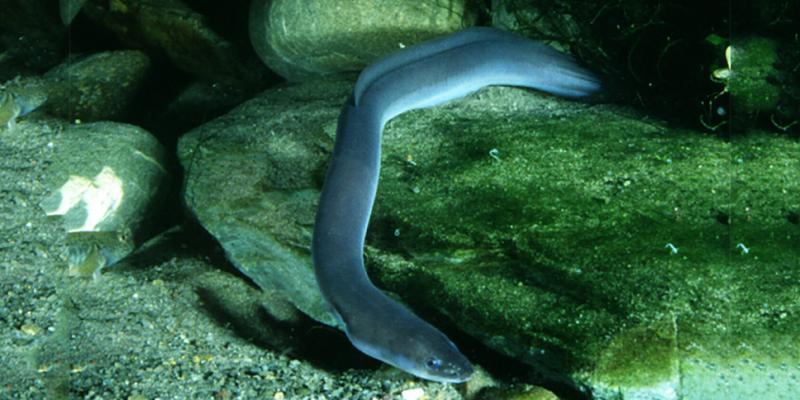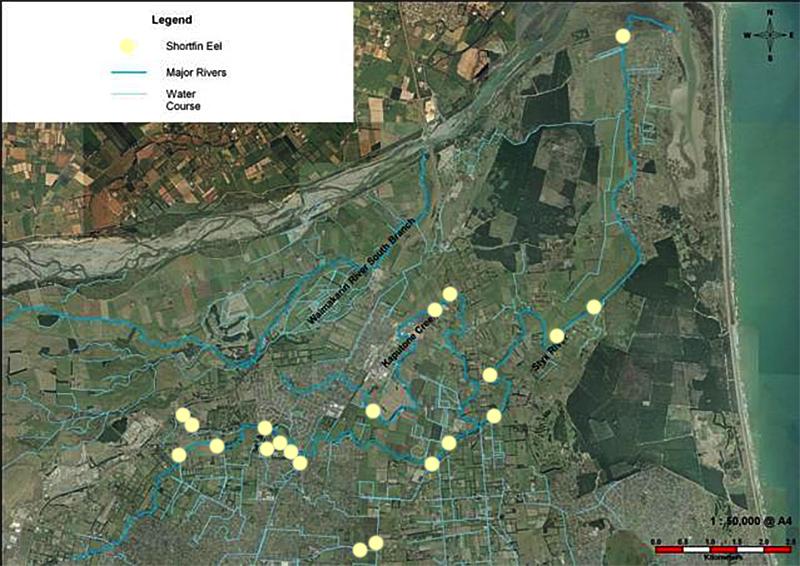Shortfin Eel
Common name Shortfin eel
Scientific name Anguilla australis
International Distribution
Gondwanaland distribution; Chatham Islands, Eastern Australia, Tasmania, New Caledonia, Lord Howe, Norfolk, Fiji, and perhaps Tahiti Islands to the north of New Zealand.
National Distribution
Indigenous (native) fish. Widespread in slow flowing lowland streams throughout New Zealand. They are also occasionally found significant distances inland, if water passage is relatively easy.
Distribution in the Styx River
Ubiquitous distribution. They have been identified in all waterways throughout the Styx River catchment, and at all elevations. It is tolerant of silted habitats and poor or indifferent water quality.
Notes on the eel fishery in the Styx River catchment
The Styx River has supported a modest commercial eel fishery over a number of years. Nationally, the pressure on eels stocks is considered by experts to be significant, and may not be sustainable in the long term.
The South Island eel fishery was introduced into the Quota Management System (QMS) in October 2001, and the total national catch has declined gradually (Ministry of Fisheries 2008). Commercial fishing effectively ceases over the winter months in the South Island, but over the 2006-07 summer, about 290 tonnes of eels were captured in the South Island. A good proportion of these are captured from Lake Ellesmere (122 tonnes), but excluding these, and for the North Canterbury region, which includes the Styx River, only 7.7 tonnes were caught, compared to a regional total allowable catch from the region of 54.8 tonnes. Other than some coastal lakes, particularly Lake Ellesmere, where most of the catch is composed of shortfin eels, the catch from most regions have a predominance of longfin eels.
Biology
The life history of the shortfin eel is similar to that of the longfin eel. Migrations of juvenile eels occur during winter and spring when they leave the sea and enter freshwater to grow and mature (McDowall 1990). Juvenile eels, also known as glass eels, are unpigmented and grow at approximately the same slow rate as the longfin eel (i.e. 9-20 mm per year, Graynoth & Taylor 2004).
Like the longfin eels, shortfin eels can become large, although do not grow to the very large size of longfin eels. The largest recorded shortfin eel in the Styx River is 900 mm in length (Eldon & Taylor 1990), but this size is unexceptional for this species.
Female shortfin eels mature after about 22 years in freshwater, males after about 14 years. When mature, shortfin adults migrate to spawn in tropical seas, although the actual spawning location remains a mystery. A Japanese research vessel caught migratory shortfin eel larvae north of New Caledonia (Aoyama et al. 1999; Jun; et al. 1999), although they are thought to spawn between Fiji and Tahiti.
References
- Aoyama, J.; Mochioka, N.; Otake, T.; Ishikawa, S.; Kawakami, Y.; Peter, C.; Nishida, M.; Tsukamoto, K. 1999: Distribution and dispersal of anguillid leptocephali in the western Pacific Ocean revealed by molecular analysis. Marine Ecology Progress 188: 193-200.
- Eldon, G. A.; Taylor, M. J. 1990. Fisheries survey of the Styx River, summer 1990. MAF Fisheries, Christchurch. New Zealand Freshwater Fisheries Report No. 120. 27 p.
- Graynoth, E.; Taylor, M. J. 2004: Growth of juvenile eels (Anguilla spp.) in lowland streams in New Zealand. Fisheries Research 66: 95-106.
- Jun;, A.; Noritaka;, M.; Tsuguo;, O.; Satoshi;, I.; Yutaka;, K.; Peter;, C.; Mutsumi;, N.; Katsumi, T. 1999: Distribution and dispersal of anguillid leptocephali in the western Pacific Ocean revealed by molecular analysis. Marine Ecology Progress 188: 193-200.
- McDowall, R. M. 1990: New Zealand Freshwater Fishes: A Natural History and Guide. Auckland, Heinemann Reed. 553 p.
- Ministry of Fisheries 2008. Fisheries Plenary Report. Ministry of Fisheries, Wellington. No. 243-255 p.






